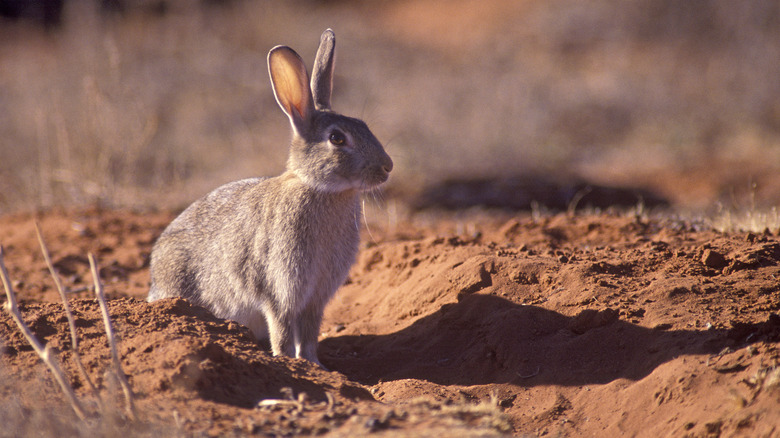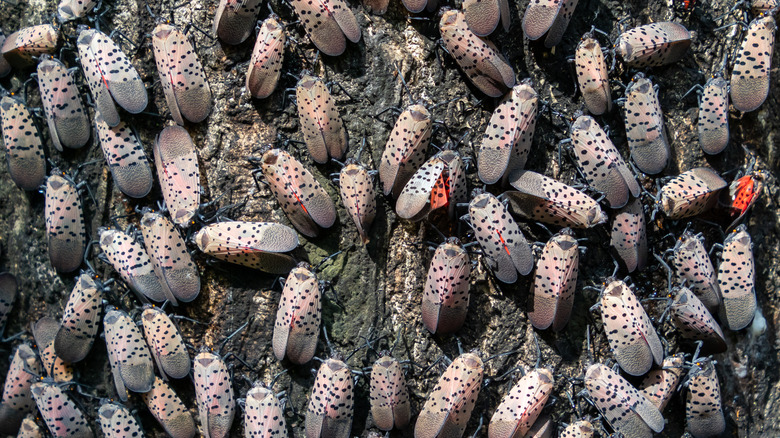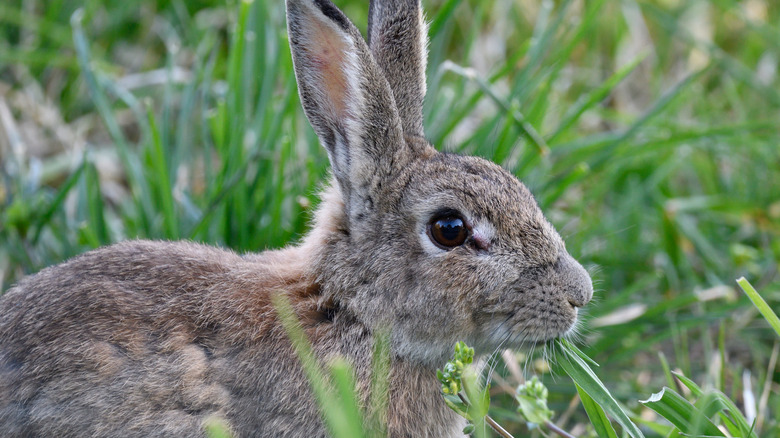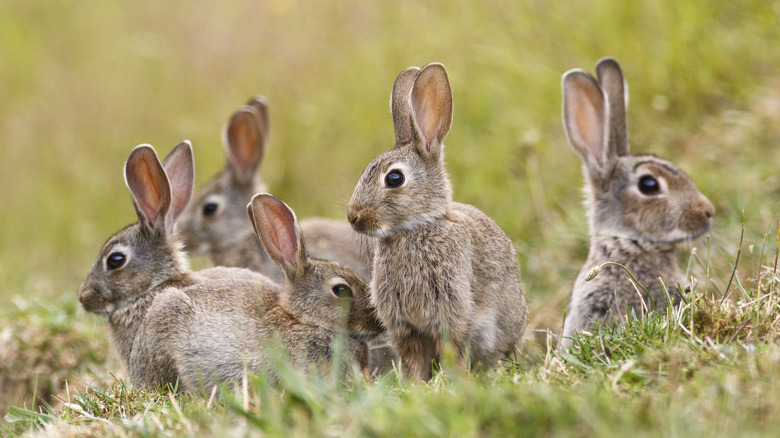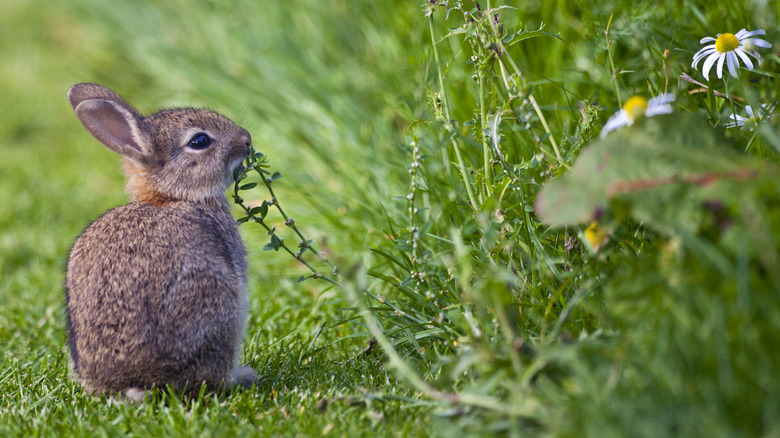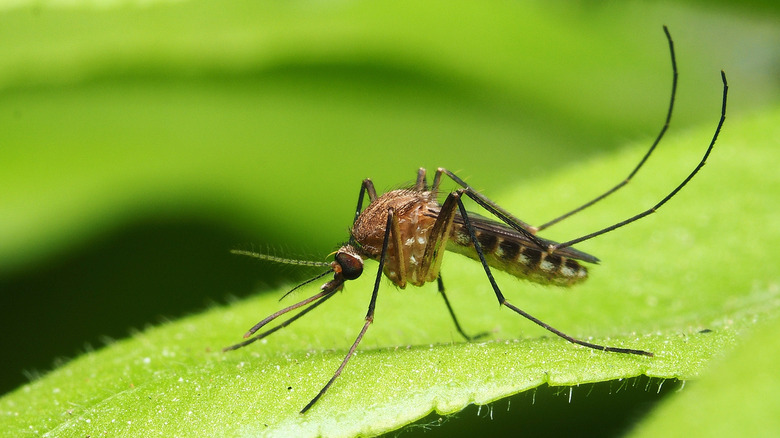The History Of Australia's Rabbit Infestation
There's a moment in the classic episode of "The Simpsons" titled "Bart vs. Australia" where the family arrives in Australia, and at the airport, Bart sees a sign that reads "ADVISORY: Foreign florae and faunae prohibited." He tells Lisa that he thought they spoke English in Australia, to which the bookish middle Simpson explains that the sign means foreign plants and animals can't be brought into the country. A disappointed Bart then takes a large frog out of his luggage and releases it into an airport fountain. The frog then goes on to multiply throughout the episode, and invasive frogs become a major nuisance — perhaps even bigger than the Simpson family — to the good people of Australia.
Of course, it's a joke, and frogs haven't taken over Australia (not yet, at least), but like a lot of great jokes, it's grounded in reality. Invasive species are a major problem anywhere in the world and can throw off an ecosystem's balance. This happened to Australia, and the rather innocent-looking culprits have caused major damage to the continent in the 150-plus years since they were introduced (via ThoughtCo).
What are invasive species?
According to the National Wildlife Federation, any living organism can become an invasive species if it is not native to an ecosystem and subsequently causes that ecosystem some sort of harm.
Invasive species often wind up competing with natives for resources. For example, lake trout were introduced into lakes near Yellowstone National Park back in the 1890s, but by 1994, they were found in Yellowstone Lake. The fish caused problems because they competed for some of the habitats as cutthroat trout, which are native to the lake and a major food source for other animals that live in the park (via National Parks Service).
Humans are typically the reason for invasive species being introduced into new ecosystems, though this is usually done unintentionally. Sometimes shipping can bring in an invasive species, and a recent example of this is spotted lanternflies. The insects are native to China but arrived in Pennsylvania in a shipment of rock, according to Bloomberg. Since they were first discovered in the United States in 2014, spotted lanternflies have gone on to multiply — thanks in part to not having any predators in the United States — and have caused damage to native vegetation (via USDA).
Rabbits were introduced to Australia so one guy could go hunting
Sometimes, invasive species are introduced entirely on purpose, though the person doing so likely doesn't understand the ramifications of their actions. Such was the case when rabbits made their way down to Australia. According to ThoughtCo, Thomas Austin was a landowner in Winchelsea, Victoria. He was born in England but arrived on the Australian continent in 1831. Austin was a sheep-herder and liked hunting, but there wasn't much to hunt in Australia the way there was back in England. So, in 1859, he decided to import 24 rabbits and release them onto his property so he could hunt them.
"The introduction of a few rabbits could do little harm and might provide a touch of home," he said at the time (via Unremembered History). These would prove to be famous last words as he was unknowingly starting a problem that would plague Australia for more than a century.
The rabbits multiplied ... quickly
Rabbits have a reputation for reproducing at a rapid rate like, well, like rabbits. In 1867 — just eight years after the initial 24 rabbits were set loose — Prince Alfred, Duke of Edinburgh, visited Austin's ranch. The two decided to have some fun by going rabbit hunting like a pair of English Elmer Fudds. Only they were far more successful than Elmer Fudd ever was because, according to Unremembered History, the pair killed 1,000 rabbits. However, there were so many rabbits left to continue having more rabbit offspring that when the Duke of Edinburgh came back the following year, they killed 1,500 more.
Their hunts were picked up by local newspapers that were starting to realize that the country could soon be facing a rabbit problem. Rabbits were brought to Australia as early as the 1780s by British settlers who then bred them, but that was the extent of the rabbit presence until Austin let two dozen loose on his property.
Rabbits became a nuisance within a few years
According to ThoughtCo, one of the primary reasons the rabbits caused such huge concern was that they destroyed the farmland, and there's not much of it in Australia. Within just a few years of being introduced, farmers in Australia were complaining that rabbits were destroying their crops. In 1864, the Australian government started offering a reward for "any method of success not previously known in the Colony for the effectual extermination of rabbits" (via Unremembered History).
They received lots of suggestions, and many of them were terrible and could've caused additional public safety issues, including the use of poison. Another method was called ripping, and it used large farming equipment to dig into the ground and do exactly what the name implies. In addition to destroying farmland, rabbits caused issues for the Australian ecosystem by eating trees and other plants that native animals relied on as a food source.
Australia built the world's longest fence to keep rabbits from spreading
The Great Wall of China was built to protect the nation from the threat of invading Mongols, and perhaps it's what inspired the idea for a wall to be used to stop the worsening Australian rabbit invasion. According to Unremembered History, the idea received government approval in 1901, but the idea of building a wall on a massive scale seemed like overkill seeing as the adversary was so small. So, they decided to build a fence. A really long fence.
At 1,138 miles and stretching from the northern part of the continent all the way to the southern, it's widely considered the longest continuous fence in the world (via ThoughtCo). A second fence runs parallel to the first but is a little farther west, while the third fence branches off the second and extends to the west coast.
Australia used biological warfare to deal with rabbits
Fences weren't the only way the government tried dealing with rabbits. According to ThoughtCo, in the 1950s, the country released mosquitos and fleas carrying the myxoma virus, which only affects rabbits. It managed to kill an estimated 90% or more of the rabbit population — only the fleas and mosquitos couldn't survive in some of the country's more arid regions, and those rabbits survived.
Around 40 years later, a second attempt was made to infect rabbits. This time, flies carrying rabbit hemorrhagic disease, or RHD, were set loose. The flies were better at surviving in the regions the mosquitos and fleas couldn't, but this method had the opposite problem — it wasn't as effective in the parts of the country with more rainfall where temperatures are generally lower.
These methods have greatly reduced the number of rabbits in Australia, but they're still a major — albeit slightly more manageable nuisance — to this day.
